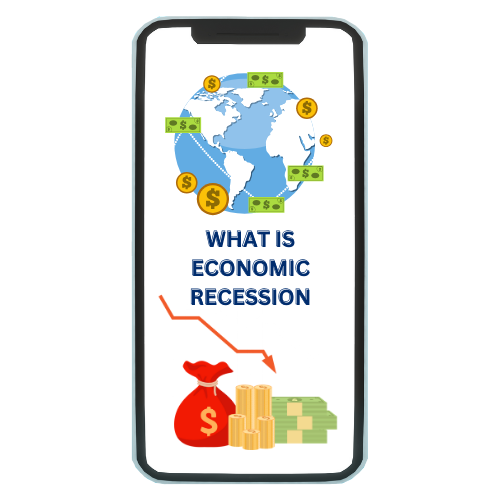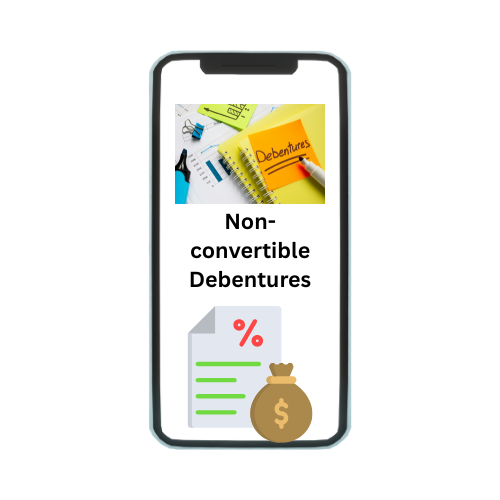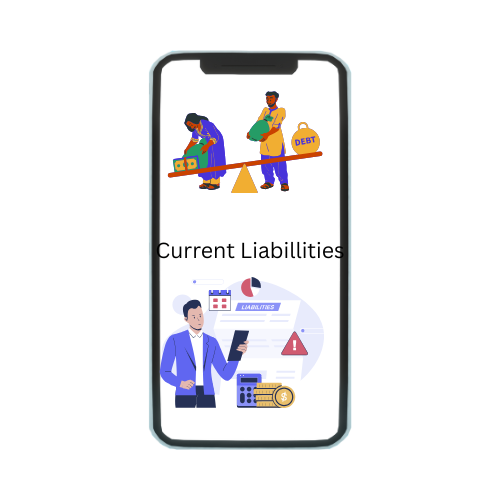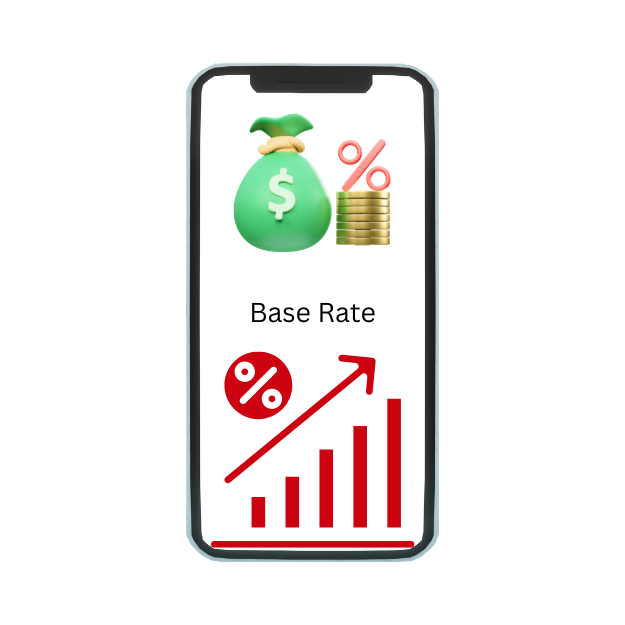An economic recession is a period of significant decline in economic activity across an economy that lasts for an extended period, often measured as two consecutive quarters of negative GDP growth. It affects various sectors of the economy, leading to widespread reductions in production, consumer spending, investment, and employment.
Key Characteristics of a Recession:
- Decline in GDP:
A sharp drop in the Gross Domestic Product (GDP), indicating that the overall economy is shrinking.
- High Unemployment:
Companies cut costs by laying off workers, causing a rise in unemployment rates.
- Reduced Consumer Spending:
People tend to spend less due to fear of job losses or reduced income, which leads to lower demand for goods and services.
- Decreased Investment:
Businesses become cautious, cutting back on investments and expansion, further dampening economic activity.
- Falling Industrial Production:
Manufacturing and other industrial sectors slow down, reducing output.
Why People Worry About Recessions:
- Job Losses and Unemployment:
One of the most direct and immediate effects of a recession is a spike in unemployment. Job losses can leave individuals and families without steady incomes, leading to financial instability and reduced living standards.
- Business Failures:
During a recession, many businesses, especially small ones, struggle to survive due to reduced consumer spending and investment. This can lead to bankruptcies and closures.
- Decline in Stock Markets:
Recessions often trigger a fall in stock prices as investors pull back due to uncertainty. This reduces wealth for those who have investments in stocks, including retirement funds.
- Reduced Access to Credit:
Financial institutions become more cautious during recessions, making it harder for individuals and businesses to get loans. This lack of credit can stifle economic recovery.
- Lower Government Revenues:
Governments collect less in taxes due to lower business profits and income taxes. This can reduce public spending on essential services like healthcare, education, and infrastructure, potentially affecting the quality of life.
- Long-Term Impact on the Economy:
A prolonged recession can cause lasting damage to an economy by slowing down innovation, reducing the workforce’s skill level, and increasing national debt through stimulus spending.
India has experienced several economic recessions or significant slowdowns over the decades, typically caused by a combination of domestic factors and global economic events. Here are some notable examples:
- 1991 Balance of Payments Crisis
- This recession was triggered by a severe balance of payments crisis. India faced a huge fiscal deficit, high inflation, and dwindling foreign exchange reserves, which were barely enough to cover three weeks of imports. Global factors like the Gulf War and rising oil prices exacerbated the situation.
- India had to pledge gold to the IMF to get a bailout. The government was forced to devalue the rupee and implement economic reforms, including liberalization, privatization, and opening up the economy to foreign investments.
- The crisis marked a turning point for the Indian economy, leading to long-term structural reforms that set the stage for higher growth rates in the following decades.
- Global Financial Crisis (2008-2009)
- Although the crisis originated in the U.S. due to the collapse of the housing market and financial institutions, it had a global impact, including on India. Exports, foreign investments, and overall global demand fell sharply.
- India’s GDP growth slowed to 3.9% in 2008-09, compared to the robust 9% growth in previous years. Key sectors like real estate, manufacturing, and exports suffered significantly. The stock markets also took a sharp hit.
- India responded with fiscal stimulus packages, monetary easing, and infrastructure investments, helping the economy bounce back with a growth rate of 8.5% in 2009-10.
- COVID-19 Pandemic (2020)
- The COVID-19 pandemic led to nationwide lockdowns in India starting in March 2020, which brought the economy to a standstill. Global supply chains were disrupted, and domestic industries like hospitality, aviation, and manufacturing were severely impacted.
- In FY2020-21, India’s GDP contracted by 7.3%, marking one of the worst recessions in its history. Unemployment surged, and many small businesses shut down permanently. The informal sector, which employs a large portion of India’s workforce, was particularly hit hard.
- The Indian government introduced a series of relief measures, including direct transfers, credit support for small businesses, and structural reforms. The Reserve Bank of India (RBI) cut interest rates and injected liquidity into the system. The economy recovered with a 9% growth rate in 2021-22, though recovery remained uneven.
- Demonetization and GST Rollout (2016-2017)
- In November 2016, the Indian government demonetized ₹500 and ₹1,000 notes, which constituted 86% of the currency in circulation, to curb black money and corruption. Around the same time, the Goods and Services Tax (GST) was rolled out in 2017, which led to initial disruptions in the informal sector and small businesses.
- GDP growth slowed down from 8% in 2016 to 6.7% in 2017. The informal sector, dependent on cash transactions, was hit hard, and there was significant uncertainty regarding the new tax structure.
- Growth picked up after the effects of demonetization and GST began to stabilize, and businesses adapted to the new tax regime. However, the slowdown left a lasting impact on several sectors, especially informal and small-scale businesses.
- Economic Slowdown (2018-2019)
- India experienced an economic slowdown prior to the COVID-19 pandemic due to a combination of factors like declining consumer demand, stress in the banking and non-banking financial sectors, and weakening global trade.
- India’s GDP growth fell to 4.2% in FY 2019-20, down from 6.1% in 2018-19. Key sectors such as automotive, real estate, and manufacturing saw sharp declines, and unemployment reached a multi-decade high.
- The government announced stimulus measures, infrastructure projects, and financial sector reforms, but recovery was slow and uneven. The pandemic worsened the situation soon after, leading to further economic contraction.
Economic Recession Fears in 2024
In 2024, fears of a global economic recession have been fueled by a combination of factors affecting both developed and developing economies, including India. These concerns stem from various macroeconomic trends and events that could push global economies into a downturn. Below are some key factors contributing to these recession fears in 2024?
- Rising Inflation and Interest Rates
- Despite efforts by central banks to control inflation, it has remained high in many countries. Price increases in essential sectors like food, energy, and housing are putting pressure on consumers and businesses, which reduces purchasing power and profit margins.
- To curb inflation, central banks, including the U.S. Federal Reserve, the European Central Bank, and others, have raised interest rates aggressively over the past couple of years. High interest rates increase borrowing costs for businesses and consumers, which slows down investment and spending. This can eventually push economies into recession.
- Global Supply Chain Disruptions
- While many countries have emerged from the COVID-19 pandemic, global supply chains have not fully recovered. Disruptions in shipping, labour shortages, and input materials have continued to create bottlenecks in production, particularly in industries like semiconductors, automotive, and electronics.
- The war in Ukraine and rising tensions between the U.S. and China have exacerbated supply chain issues. Sanctions, trade restrictions, and disruptions in energy supply (especially in Europe) are further inflating production costs, which contribute to the overall economic slowdown.
- Geopolitical Uncertainty
- The Russia-Ukraine conflict, ongoing since 2022, continues to disrupt global markets, particularly in energy and agriculture. European economies, which are heavily reliant on Russian gas and Ukrainian grains, have been significantly affected. Rising energy prices and food costs have increased the risk of recession in Europe, with global spill over effects.
- Tensions between the U.S. and China over trade, technology, and geopolitics have added to the uncertainty. The potential for tariffs, sanctions, or decoupling of critical industries like semiconductors has made businesses hesitant to invest, creating concerns about a broader global slowdown.
- Slowing Economic Growth in Major Economies
- Although the U.S. economy grew in 2023, it faces the prospect of slowing down in 2024 due to high interest rates, reduced consumer spending, and weak corporate investment. Given the size of the U.S. economy, a slowdown here would likely trigger ripple effects worldwide.
- China, which was once a major driver of global growth, is facing its own economic challenges. The country’s real estate crisis, high debt levels, and weaker-than-expected post-COVID recovery have dampened its growth outlook. With China being a significant trade partner for many countries, its slowdown raises fears of a global recession.
- Potential Financial Sector Instability
- The collapse of several regional banks in the U.S. in 2023, along with concerns about the stability of the broader banking sector, has raised fears of a financial crisis in 2024. Although swift central bank intervention helped stabilize markets, concerns remain about high debt levels, especially in the corporate and real estate sectors.
- Rising interest rates have made it more expensive for governments, companies, and households to service their debts. Emerging markets with high levels of foreign debt are particularly vulnerable to currency depreciation and rising borrowing costs, which could trigger defaults and capital outflows.
- Declining Consumer and Business Confidence
- As inflation eats into household incomes and interest rates rise, consumers in many countries have cut back on spending. This drop in demand has hit sectors like retail, housing, and automotive, which are key contributors to GDP growth.
- With uncertainty around inflation, supply chains, and geopolitical issues, businesses have become more cautious in making large investments or hiring. This lack of investment can stifle economic growth and lead to a prolonged recession.
- Energy Crisis
- Oil prices, which were volatile throughout 2023 due to supply cuts from major producers like OPEC+, continue to pose risks for 2024. High oil prices increase production costs for businesses and transportation costs for consumers, which can slow economic growth.
- While the world is transitioning to renewable energy, the process has created supply-demand imbalances in traditional energy sources. Sudden price increases in fossil fuels could lead to inflation spikes, further fuelling recession fears.
- Emerging Markets Vulnerability
- Although India is one of the few major economies projected to grow in 2024, it is not immune to global risks. High inflation, interest rates, and global supply chain disruptions could impact India’s domestic industries, particularly manufacturing and exports.
- Countries like Brazil, Turkey, and South Africa are vulnerable to the rising cost of debt, capital outflows, and currency depreciation. This could lead to financial instability and reduce their growth prospects, dragging down the global economy.
Can there be a global recession in future??
A global recession in the future is certainly possible, but predicting it with precision depends on various factors. Historically, recessions are cyclical, meaning they come in waves following periods of growth, but their timing, duration, and severity depend on several key drivers:
- Monetary Policy and Interest Rates
- Central banks, particularly in major economies (U.S. Federal Reserve, European Central Bank, etc.), play a big role in managing economic growth through interest rates. If rates are raised too aggressively to combat inflation, it can slow down borrowing and investment, potentially triggering a recession.
- Geopolitical Risks
- Events like trade wars, conflicts (e.g., between large economies or regions), or sanctions can disrupt global supply chains, causing economic shocks. The Russia-Ukraine war is an example of such an event affecting global energy and food supplies.
- Debt Levels
- High levels of public and private debt, particularly in emerging economies or highly leveraged sectors, could become unsustainable in the face of rising interest rates or slower economic growth, leading to defaults and a financial crisis.
- Pandemics and Health Crises
- COVID-19 showed how a global health crisis could cause severe economic disruptions. Future pandemics or other widespread health threats could lead to significant economic slowdowns.
- Climate Change and Natural Disasters
- The increasing frequency of extreme weather events due to climate change can disrupt economies, cause losses, and necessitate huge adaptation investments. Major disasters, such as floods, fires, or droughts, could have global economic impacts.
- Financial Markets and Speculative Bubbles
- Stock market bubbles, fueled by speculation and excess liquidity, can burst and cause widespread losses in global markets. Overvaluations in sectors like tech, real estate, or cryptocurrencies could lead to crashes, triggering broader economic downturns.
- Global Supply Chain Disruptions
- Issues like semiconductor shortages, energy crises, or disruptions in raw materials (e.g., due to geopolitical tensions or natural resource scarcity) can slow global trade and manufacturing, leading to global economic contractions.
- Inflation
- Persistently high inflation can erode consumer purchasing power and squeeze corporate profits. Stagflation (slow growth combined with inflation) is particularly damaging, as it is hard to combat with traditional economic tools.
Early Warning Signs of a Recession:
- Inverted Yield Curve:
This often signals that investors are concerned about future economic growth.
- Declining Business Investment:
Reduced corporate spending on capital goods or hiring is a strong indicator.
- Falling Consumer Confidence:
When consumers cut back on spending, it affects the broader economy.
Many experts agree that while recessions are inevitable, their causes and timing are hard to predict. Future global recessions could be triggered by one or a combination of the factors above. However, governments and central banks also have tools to manage and mitigate these risks, such as fiscal stimulus, monetary easing, or regulatory interventions.





